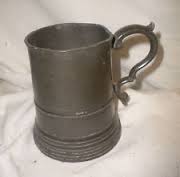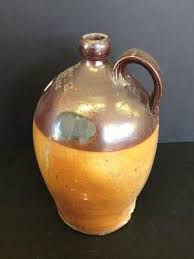I was able to participate in archaeological lab work this week and I do not think I have ever been so excited to look at broken fragments of beer jugs like the one below.
Looking at a variety of artifacts from an excavation site in Annapolis, Maryland, I saw bags containing fish bones and mammal bones and at first look they all look the same. However, my professor was an expert in identifying bones and was able to explain distinctions between them. Small details like size and curvature along the bone edges can indicate to which animal a bone belonged. Over a course of two hours, I got pretty good at identifying pig toes. Also, we looked at different glass and we learned that vessel glass was most likely used as a container because it is identifiable by its shape. It is rarely flat like window glass.
Lab work was a chance to conduct cultural and historical interpretation from the artifacts we examined. For example, pieces of a jug we looked at like the one below shows agricultural adaptation specifically because of the small opening at the top. We can likely infer that this type of jug was used for liquids or the people who owned this jug wanted to regulate exactly how much they wanted to come out of the jug or put in. This piece of pottery is technological evidence that with analysis can give clues on the activities of the community during a time. An archaeologist can have an idea of the tool and pottery advancement, which can be telling of the social systems, and ideology of the people in the past.
The purpose of lab work is to reconstruct the past and archaeologists use analogy to help. In archaeology, analogy is used to infer the identity of and relationships among archaeological data by comparing them with similar phenomena documented in human societies that are living or recorded historically (Ashmore, 180). Unknowingly, I was using analogy during my time in the lab. When examining the beer jug, I was comparing it to what I had previously seen today’s society. I thought about the evolution of the beer jug turned beer bottle and noticed that because of its similarities in form, reconstruction was easier to understand.
Artifacts provide information about societies’ cultures, environments, people, and animals. Artifacts are common but it is the history behind the item that reveals the value; thus, all artifacts should be respected and deemed valuable.
For further information on archaeology analogy, check out Wendy Ashmore’s and Robert J. Sharer’s book Discovering Our Past: A Brief Introduction to Archaeology.
Works Cited:
Ashmore, W.J., and Sharer, R.J., Discovering Our Past: A Brief Introduction to Archaeology. 6th Edition.



As you mention here, even shards of glass can be identified as pieces of vessels, thanks to their unique curvature. Study of glass shards is an important feature of historic archaeology; sometimes, the texture and color of the shards can give even more insights into the uses and historical context of the bottle from which they came. For more recent sites, the embossing on glass bottles may even be preserved, which allows archaeologists to date them even more precisely. For example, during our fieldwork in the Catskills, one group found a fragment of a glass bottle with “Clorox” clearly embossed on its surface – a telling detail, given that the Clorox Company was founded in 1913 but stopped selling bleach in glass bottles in 1962. Considered in context with other artifacts at the site, the bottle helped date the site to the 1940s. In a different vein, archaeologists can also track alcohol consumption at certain sites by the glass; liquor and beer bottles were historically made with colored glass, just as they are today. Their forms also changed quite frequently over the years, and can be useful in dating as well. With the help of typologies, glassware can sometimes be quite efficiently dated. For instance, check out this website from the US Department of the Interior, which charts the historical permutations of many different types of bottles, including alcohol, medicinal, and domestic vessels: http://www.sha.org/bottle/typing.htm